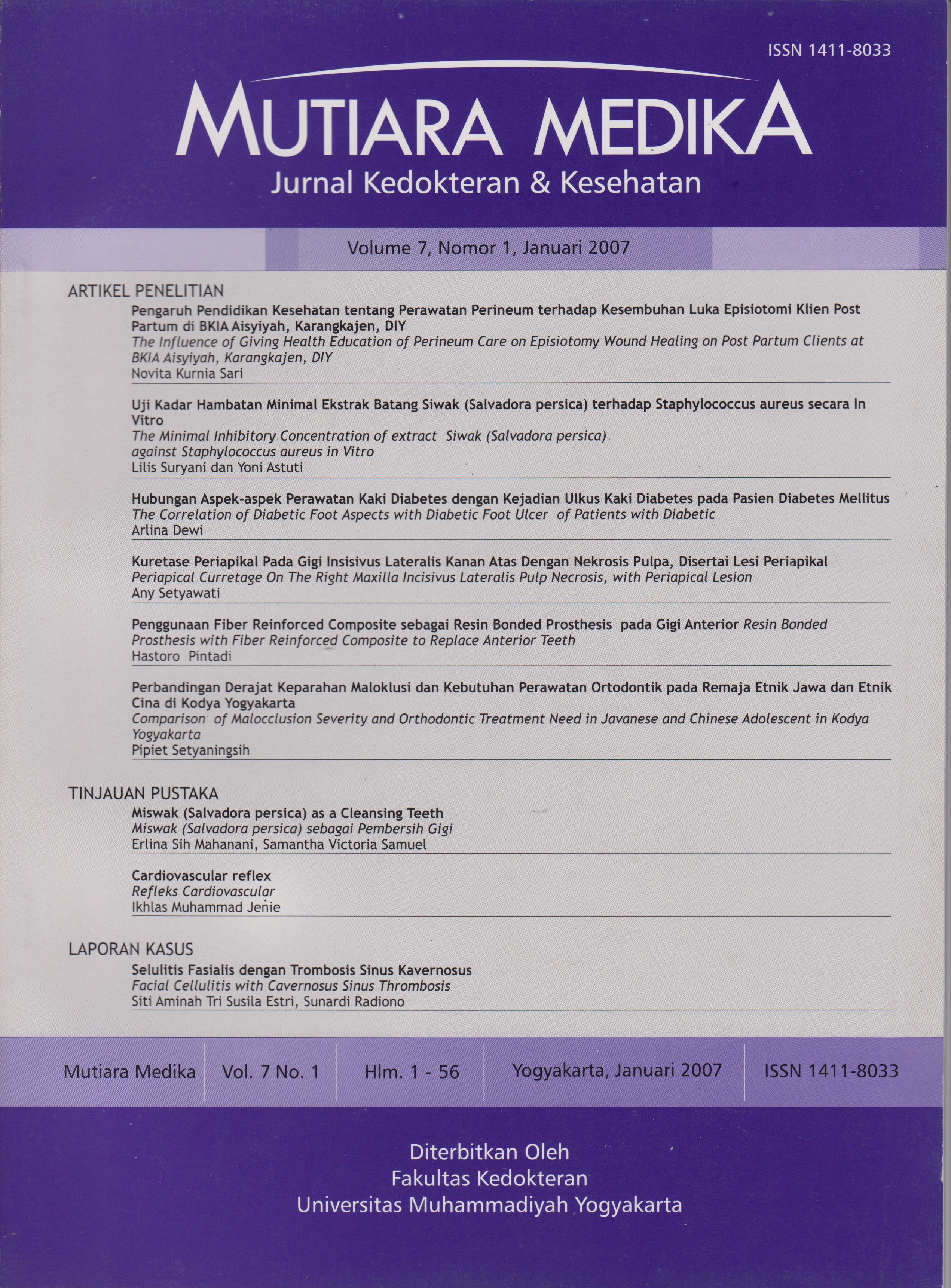MISWAK (Salvadora persica) as a Cleansing Teeth
DOI:
https://doi.org/10.18196/mmjkk.v7i1.1696Keywords:
Miswak, Salvadora persica, oral hygieneAbstract
Miswak is a chewing stick that derives from Arak tree (Salvadora persica) which is used as cleansing teeth. It is used in different part of Africa, Asia especially in Middle East, South of America,2 India, Pakistan and mostly of Muslim community. This custom was adopted and Islamized by Prophet Muhammad (Peace and Blessings of Allah be upon Him/PBUH) because there are several hadith mentioning the benefits of siwak in maintaining oral hygiene. Many studies have been done to explore the oral hygiene advantages of this stick. Salvadora persica contains trimethylamine, salvadorine, chloride, fluoride, silica, sulphur, mustard oil, vitamin C, resins and traces of tannins, saponins, flavonoids and sterol. Actually this chemical composition influence to the oral hygiene. The unique chemicals component, fibers proved the effect to periodontal status, caries, antimicrobial, cleanness, whitening, calculus removal, and so on. Furthermore miswak is generally used for a longer period of time and frequency (because it is used at least 5 times a day before praying). So normally the miswak users have higher oral hygiene status.References
Arafa H, Prophetic Medicine: An Old Prescription for a New Era, www.IslamOnline.net
Al-Sadhan RI and Almas K, 1999, Miswak (chewing stick): A Cultural and Scientific Heritage, The Saudi Dental Journal; 11: 2, 80-88
Darout IA, Miswak as an alternative to the modern toothbrush in preventing oral diseases, research report, Institute of Odontology-Oral Microbiology, faculty dentistry and Centre for International Health, University of Bergen, Norway.
Farooqi MIH, Srivastava JG (1968). The tooth-brush tree (Salvadora persica). Quart J Crude Drug Res, 8: 1297-1299
Ezmirly ST, Cheny JC, Wilson SR (1978). Saudi Arabian medical plants: Salvadora persica. Planta Medic, 35: 191-192
Elvin-Lewis M (1982). The therapeutic potential of plants used in dental folk medicine. Odontostomatol. Trop, 5: 107-117
Hattab FN (1997). Meswak: the natural toothbrush. J Cin Dent, 8(5):125-9.
Batwa M, Bergstrom J, Batwa J, Al- Otaibi MF, The effectiveness of chewing stick miswk on plaque removal, Saudi Dental Journal;18 :3:125 abstract
Al-Lafi T, 1988, Effectiveness of Miswak as a tool for oral hygiene, MSc thesis, University of London.
Al-Bagieh NH, Idowu A and Salako NO, 1994, Effect of aqueous extract of miswak on the in vitro growth of Candida albicans. Microbios, 80(323):107-13.
Almas K, Al-Bagieh, and Akpata ES, 1997, In vitro antibacterial effect of freshly cut and 1-month-old Miswak extracts, Biomedical Letters;56;145-9
Darout IA et al, Salivary microbiota levels in relation to periodontal status, experience of caries and miswak use in Sudanese adults, 2002, Journal of Clinical Periodontology, Vol 29: 5 Page 411-420
Gazi M, Saini T, Ashri N, Lambourne A, 1990, Meswak chewing stick versus conventional toothbrush as an oral hygiene aid, Clin Prev Dent;12 :19-23
Darout IA and Skaug N, 2004, Comparative oral health status of an adult Sudanese population using Miswak or toothbrush regularly, Saudi Dental Journal;( 1):29-38.
Almas K, al Lafi T, 1995, The natural toothbrush, World Health Forum; 16: 206-10
Kubota K, et al, 1988, Effect of tannic acid on adherence of candida to denture base, J of Dental Research; 67:abstract 183
Baghdady VS, and GhoseLJ, 1979, Comparison of the severity of caries attack in permanent first molars in Iraqi and Sudanese schoolchildren, Community Dent Oral Epidemiol;7:346- 8
Carl W, and Zambon JJ, 1993, Dental health of the rendille and Samburu of the northern frontier district of Kenya, NY StateDent J;59:35-9
Samuel SA, Mahanani ES, and Arief EM, 2007, The effectiveness of Salvadora persica at Removing Tea and Chlorhexidine Stain, elective Project DDS USM, Kelantan, Malaysia
Downloads
Published
Issue
Section
License
Copyright
Authors retain copyright and grant Mutiara Medika: Jurnal Kedokteran dan Kesehatan (MMJKK) the right of first publication with the work simultaneously licensed under an Attribution 4.0 International (CC BY 4.0) that allows others to remix, adapt and build upon the work with an acknowledgment of the work's authorship and of the initial publication in Mutiara Medika: Jurnal Kedokteran dan Kesehatan (MMJKK).
Authors are permitted to copy and redistribute the journal's published version of the work (e.g., post it to an institutional repository or publish it in a book), with an acknowledgment of its initial publication in Mutiara Medika: Jurnal Kedokteran dan Kesehatan (MMJKK).
License
Articles published in the Mutiara Medika: Jurnal Kedokteran dan Kesehatan (MMJKK) are licensed under an Attribution 4.0 International (CC BY 4.0) license. You are free to:
- Share — copy and redistribute the material in any medium or format.
- Adapt — remix, transform, and build upon the material for any purpose, even commercially.
This license is acceptable for Free Cultural Works. The licensor cannot revoke these freedoms as long as you follow the license terms. Under the following terms:
Attribution — You must give appropriate credit, provide a link to the license, and indicate if changes were made. You may do so in any reasonable manner, but not in any way that suggests the licensor endorses you or your use.
- No additional restrictions — You may not apply legal terms or technological measures that legally restrict others from doing anything the license permits.






